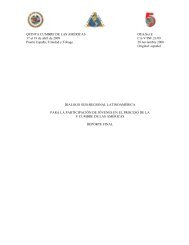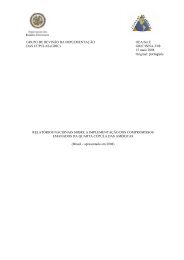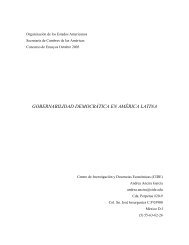The Road to Hemispheric Cooperation: Beyond the Cartagena
The Road to Hemispheric Cooperation: Beyond the Cartagena
The Road to Hemispheric Cooperation: Beyond the Cartagena
Create successful ePaper yourself
Turn your PDF publications into a flip-book with our unique Google optimized e-Paper software.
Figure 3: Affordability of Fixed Broadband 11<br />
Bolivia (Plur. State of) 81.5%<br />
Belize<br />
51.0%<br />
Nicaragua<br />
50.3%<br />
Paraguay<br />
38.3%<br />
Guatemala<br />
24.6%<br />
Suriname<br />
22.7%<br />
El Salvador<br />
21.9%<br />
Latin America average<br />
16.9%<br />
Caribbean average<br />
16%<br />
Dominican Rep.P<br />
8.1%<br />
Ecuador<br />
7.9%<br />
Peru<br />
7.9%<br />
Costa Rica<br />
6.0%<br />
Chile 3.9%<br />
Uruguay 3.6%<br />
Colombia 3.6%<br />
Brazil 3.0%<br />
Barbados 2.8%<br />
Mexico 2.3%<br />
Jamaica 2.3%<br />
Argentina 2.2%<br />
Panama 1.6%<br />
Trinidad and Tobago 1.1%<br />
Canada 0.6%<br />
OECD average 0.6%<br />
United States 0.2%<br />
0% 10% 20% 30% 40% 50% 60% 70% 80% 90%<br />
Percentage of income<br />
Source: ECLAC, Broadband for Development and Inclusion, 2011<br />
Broadband for Development and Inclusion 8<br />
Data on penetration, quality, price and affordability of<br />
broadband Internet service in LAC countries shows a<br />
mixed situation.<br />
In <strong>the</strong> 2000s, LAC countries have steadily increased <strong>the</strong>ir<br />
share of Internet users, applications and spending on incorporating<br />
<strong>the</strong>se technologies. Regarding infrastructure, <strong>the</strong><br />
region has begun <strong>to</strong> converge with high-income Organisation<br />
of Economic Co-operation and Development (OECD)<br />
countries in terms of fixed and mobile telephone penetration,<br />
although most mobile phones in <strong>the</strong> region are payas-you-go<br />
and are used mainly for voice and messaging<br />
services. This is not <strong>the</strong> case with mobile broadband access,<br />
however, where countries are rapidly falling fur<strong>the</strong>r<br />
behind <strong>the</strong> high-income OECD countries. So while <strong>the</strong> gap<br />
in telephone services has closed, a new gap (in broadband<br />
access) has opened. Low broadband penetration is even<br />
more critical in less developed countries, in lower-income<br />
households and in rural areas. Figure 2 shows <strong>the</strong> increasing<br />
differences in penetration, principally in <strong>the</strong> case of mobile<br />
broadband. This could be particularly worrisome for <strong>the</strong><br />
region, since this form of access would be <strong>the</strong> most viable<br />
way <strong>to</strong> expand broadband service on a massive scale.<br />
O<strong>the</strong>r dimensions of <strong>the</strong> broadband gap relate <strong>to</strong> deficiencies<br />
in quality of access, measured in terms of transmission<br />
capacity, long latency times and high costs. <strong>The</strong><br />
fact that <strong>the</strong> significant increase in <strong>the</strong> numbers of broadband<br />
users and subscribers has not been accompanied<br />
<strong>The</strong> <strong>Road</strong> <strong>to</strong> <strong>Hemispheric</strong> <strong>Cooperation</strong>: <strong>Beyond</strong> <strong>the</strong> <strong>Cartagena</strong> Summit of <strong>the</strong> Americas<br />
<strong>The</strong> Brookings Institution ❘ Latin America Initiative<br />
13








